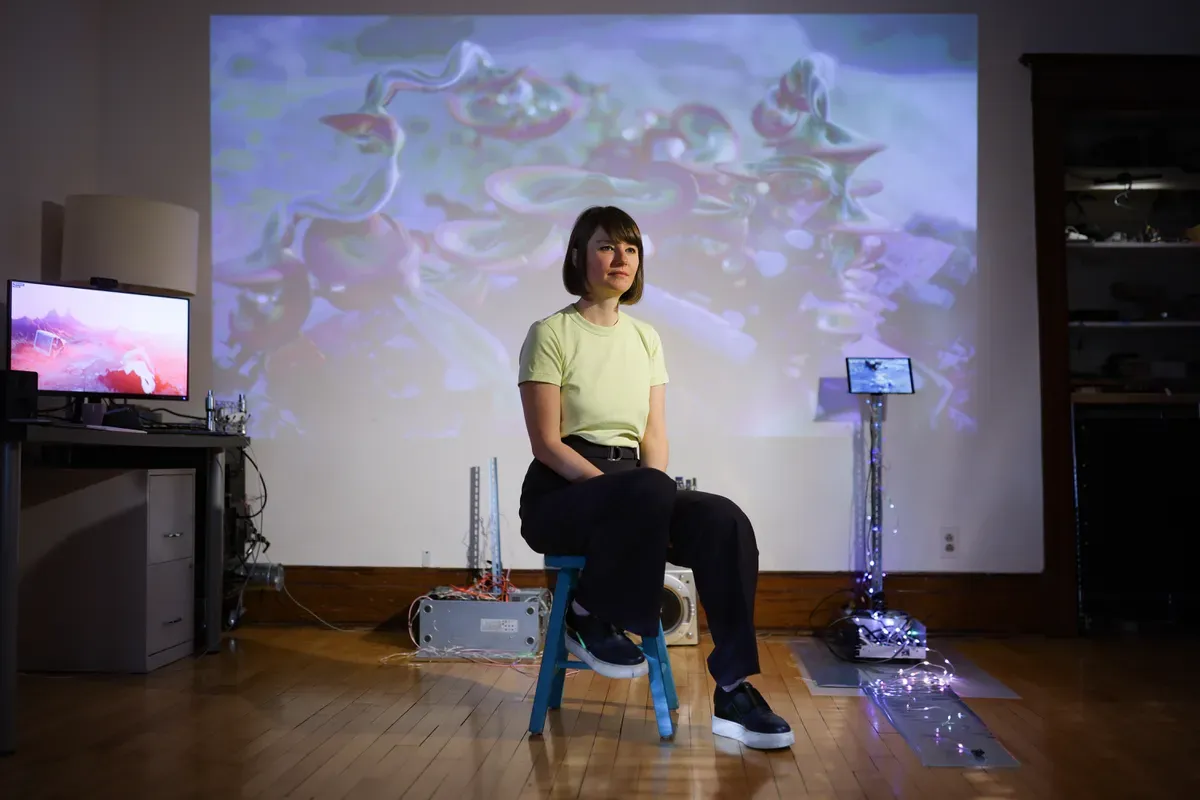People stare at screens more often than anything else these days, making technology no longer a distraction from reality but an inescapable part of it. Undoubtedly, digitalization has transformed many lives in extraordinary ways, both for better and for worse. However, nothing can be said for certain, as the story of life on Earth is not over — at least not yet.
Breaking away from familiar aspects of everyday existence, Canadian artist Sabrina Ratté’s solo exhibition Futurs Spéculaires at Arsenal Contemporary Art in Montréal takes exploration to the extreme to examine the evolving relationship between nature and technology. Her installations incorporate vivid lights, ethereal sounds, and plenty of imagination to immerse audiences in an alternate universe.

Ratté’s art alludes to the United Nations Sustainable Development Goal for Life on Land, or the possible lack thereof in the future. Through her works, viewers are reminded to protect the planet and its plants, places, and people from creative destruction. They are also invited to travel far into the future and contemplate questions in subjects ranging from geography to philosophy.
Each installation in this exhibition involves a distinct process for navigating boundaries between the real and the virtual. According to Ratté, she draws inspiration through reading an eclectic mix of works in science fiction, surrealism and metaphysics, resulting her in crafting her unique visual representations.
"I understand ideas better by creating art," she said in an interview with Arts Help.
The artist is drawn to the beauty of possibility, which explains why her default medium is usually video or digital image. Using software allows for successive iterations that result in animated objects, edited prints, even 3D-printed sculptures. "Whenever I create digital art, the images can feel so real. It's almost as if I can touch or enter them. So, it feels natural to expand these ideas into a space to experience them physically," Ratté explained during the interview.
Inflorescences is one example of this immersive experience, achieved by assembling electronic waste and 3D scans of coral-like sculptures. Ratté is unique in imagining a new kind of creature that emerges following the downfall of civilization, one that lives off the electricity that lingers inside circuits. Her work zooms far out to view life on land from a new angle, where human impact is visible but no longer the focus.
Likewise, Floralia concerns the evolution of nature and its collision with technology. It is inspired by Greg Egan's science fiction novel Diaspora (1997), where immortality is realized through conscious software. This installation shows a future where access to nature is confined by virtual means, as plants and flowers are preserved in computer archives. "I don't necessarily believe this is what will happen. I don't know what the future will be like, but I do like to imagine different scenarios," Ratté said.
Monades present a different transhumanist scenario with four prints of cyborg-goddesses in different environments. The title is a reference to German philosopher Gottfried Leibniz's Monadology (1714), a text that describes how the world is filled with "monads," or smaller parts reflective of a larger reality. This concept is thus visualized in Monades with figures reflecting the colours and textures of their surroundings.
Ratté used photogrammetry to scan her own body to obtain images that were then digitally altered to appear less human. "I'm fascinated by how technology shapes human life and psychology. I think it has made us see the world in more pragmatic ways. I use my body here as a kind of material to deconstruct and reconstruct, as if it were architecture," she said.
On top of the physical, Terraforma looks at how human technology might change temporal aspects of the world. This work was commissioned by Hermès for Watches and Wonders in Geneva. By extracting landscapes in various time zones from Google Maps and transforming these environments with 3D modeling software, Ratté creates another surreal world where life is experienced differently. Here, day and night alternate in both cyclical and non-linear ways.
From electricity-powered life forms and digitally documented flowers to solitary cyborgs and time warps, each piece in Futurs Spéculaires has its own story. The exhibition at Arsenal Contemporary Art sparks countless ideas and questions about what life on this planet will be like in the future but lacks definitive answers. When asked about what she hopes audiences will take away, Sabrina Ratté pauses before admitting that she does not intend to make people think a certain way.
Instead, the artist is interested in providing this open space where visitors can take time to wonder, perhaps project themselves in the images and get something personal out of it. Embracing the future with all its uncertainty, Ratté added, "We are always asked about our opinions these days, but I don't think we need to have an opinion on everything. We can also leave things to our senses, follow our intuition, and keep our mind open to different perspectives."
